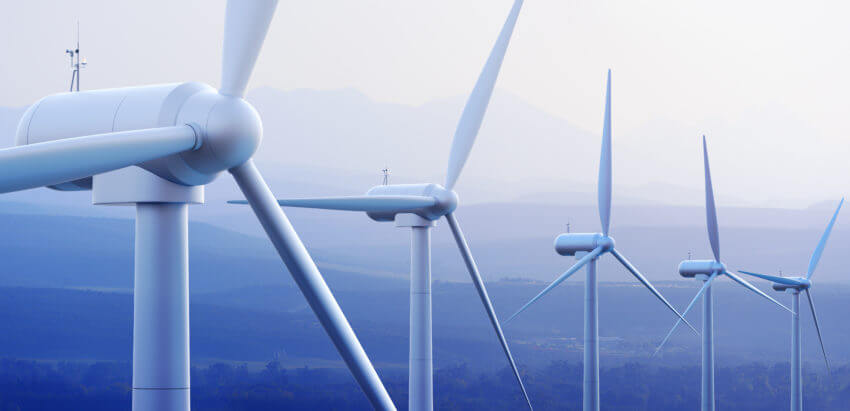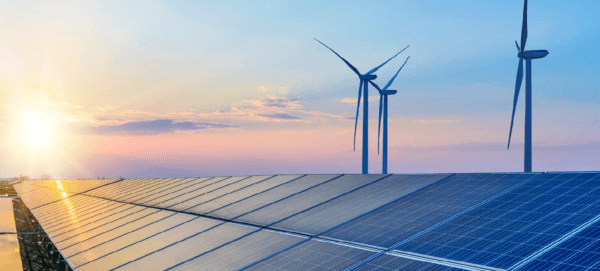Wind power sceptics are full of hot air

The UK boasts a well-established wind power market, as well as Dogger Bank, which will become the world’s largest offshore wind farm. So why does wind power generation here have so many vocal critics? Mitie’s Head of Energy Markets Research, Alan Whitefield, responds to the most common claims.
It was only a matter of time before those questioning the value of decarbonisation turned their attention to UK wind power.
They’ve had it in for solar, but recently renewable wind energy has been enjoying a spell in the sceptical limelight.
Negative headlines in the national press have included:
- When it’s too windy for wind turbines: the downside of eco-power
- Too windy for a WIND TURBINE!
- Britons paying hundreds of millions to turn off wind turbines as network can’t handle the power they make on the windiest days
- Stormy times for offshore wind
I’ve also noticed that online energy articles – even those that are well-researched, balanced and uncontentious – are attracting more anti-wind, anti-green comments.
Let’s take a look at some of the claims to see if they stand up to scrutiny…

‘Wind power is a waste of time because conditions need to be just right’
An influential British newspaper columnist took this line after realising wind turbines only operate within certain parameters. They don’t generate when there isn’t enough wind. And likewise, they shut down when winds are too strong. According to endesa.com, that’s when wind speeds reach over 90kph. But – and it’s a big but – the operable range within which wind turbines function perfectly well is very large indeed.
Let’s face it, in the UK winds are going to vary. But the data shows wind has never produced more power for us. In fact, 2023 has become the record year for total wind generation in the UK, with the country exceeding 63 TWh of wind energy. This is double the wind power generated in 2017 (BM Reports). In fact, on 21 December 2023, between 8 and 8:30am, wind briefly provided over 62% of the UK’s energy generation mix.
So we’re not even close to packing up the turbines when year-on-year we’re generating more wind electricity, despite the variation in what’s generated each day.
‘The cost of creating wind power is too high’
It’s true – costs are rising. But they’re rising across all sectors for a range of reasons, including the breakdown in supply chains due to Covid-19 and the gas and oil crisis. None of these factors solely relate to wind power in the UK. On the bright side, inflation can’t keep going up forever. Eventually we’ll see costs coming down across the board. It’s also likely that as wind energy spreads, the technology and parts required to make the turbines will come down in price too.
It’s worth remembering that even with high costs, many companies are still investing. Scotland’s largest wind farm, Seagreen, was commissioned in October last year. The windfarm is a joint venture between France’s global multi-energy company, TotalEnergies, and the UK’s SSE Renewables. Seagreen will be able to power 1.6m homes and will displace around 2m tonnes of CO2 emissions from fossil fuel generation. In short, a big win for wind.
‘The national grid can’t absorb all the wind power generated on the windiest days’
While this is true, it doesn’t make sense to lay the blame on wind power. This is a grid capacity issue that unfortunately successive governments have failed to solve. It’s a shame that when we’re generating the most wind power, it can’t always be absorbed into the National Grid. Ultimately the consumer pays; the Carbon Tracker thinktank calculated UK households paid an additional £40 for electricity in 2023 due to wasted wind power.
Putting this right is the responsibility of Government, utilities companies and businesses. The grid should be developed to fully support the switch to wind power and other forms of renewable energy generation. It was encouraging to hear the Government’s plans to put this right in the Autumn Statement, with the announcement of the Connections Action Plan.
Regardless of inefficiencies, it’s worth nothing that in 2022, a record 40% of UK energy came from renewable sources. The increase in renewable energy generation over the last six years has contributed to a much lower need for gas in the power generation mix. Coal generation has also reduced significantly over this period, with UK coal use almost halving between 2021 and 2023 (2.8 TWh, compared with 5.0 TWh in 2021). If issues with the National Grid were resolved, these figures would be even more impressive. Source: BM Reports
‘Wind power companies are struggling’
It’s true wind power companies have been facing stormy times – few have enjoyed a financial windfall. The German Government has stepped in to help out Siemens Energy amid trouble at its wind turbine division. And last year the Swedish firm, Vattenfall, announced it was stopping work on the Norfolk Boreas windfarm due to rising costs. Meanwhile Orsted, one of the world’s leading offshore wind developers, has been downgraded by credit rating agency, S&P.
So yes, times are tough. But Siemens and Orsted are just two examples of companies that took the sustainability bull by the horns and invested to make decarbonisation happen. Without such initiative there is no way net zero will be reached by 2050.
There is a case to argue that governments should step in to help such firms through these difficult times. In a recent positive move the UK Government lifted the price paid for wind energy by 66% to encourage investment. Wind is also an established part of renewable energy generation. If it were to be abandoned, there isn’t another form of renewable energy in the UK that can make up the shortfall.
In the UK, the challenge of decarbonisation is being felt by all political parties. Recently they do seem to be trying harder to see that we reach net zero by 2050 by putting more support in place.

For example, both the Conservative and Labour parties have pledged to speed up Nationally Significant Infrastructure Projects, or NSIPs. This is necessary because large-scale projects that we need to reach net zero are being delayed by red tape. In Germany and elsewhere, planning for renewables infrastructure has been relaxed, so it would be helpful if the UK followed suit.
But there is more that could be done. Improving capacity would solve the problem with the National Grid detailed above. At the Labour Party conference in October, Shadow Secretary of State of Climate Change and Net Zero, Ed Miliband, announced plans for the Energy Independence Act. This would rapidly increase the UK’s renewable energy capacity. Similarly, Prime Minister, Rishi Sunak, pledged to bring forward reforms to energy infrastructure, which will enhance grid capacity. However, there has been widespread criticism of less progressive decisions, such as delaying the UK ban on new petrol and diesel cars from 2030 to 2035.
It’s important we don’t lose momentum. And it’s concerning the UK has slipped from the top five most attractive countries for renewable energy investment. We’re now ranked seventh, yet in 2022 we were third. To keep to the UK’s decarbonisation commitments, as well as maintain our positive investment potential, we really need to see more support from government. Collaborating with the private sector will ultimately benefit everyone. Wind’s place in the energy mix isn’t going to blow over, so there’s no reason for wind power companies to be struggling.
Do you agree with Alan? Share your thoughts by emailing [email protected].
Read next
Mitie’s Net Zero Navigator 2024 reveals decarbonisation predictions
Mitie has launched its Net Zero Navigator 2024, which reveals nine key decarbonisation predictions for the year ahead whilst offering advice and support for organisations taking their next steps on the transition to net…

The heat is on for solar sceptics
If you’ve noticed a recent escalation in anti-solar rhetoric, you’re not alone. A range of voices have questioned whether the UK should be championing the sometimes unpredictable form of energy generation. Here Mitie’s Energy…

6 ways to reduce your organisation’s carbon footprint
With over half of the UK’s largest organisations committed to eliminating their carbon emissions by 2050*, there’s growing momentum to reduce our collective carbon footprint. The climate crisis, and the recognised impact of global…